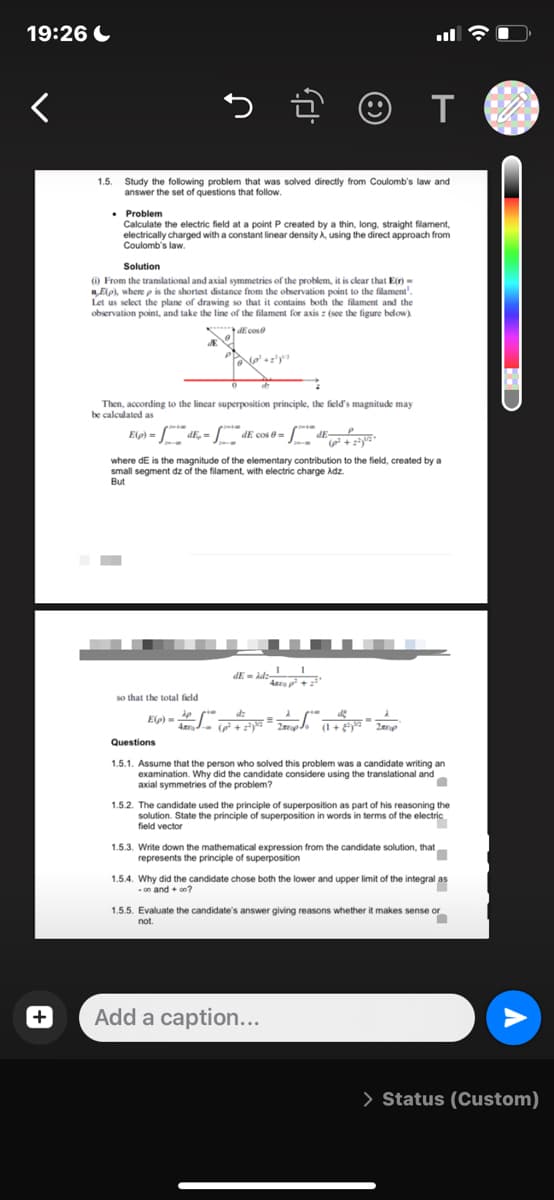1.5. Study the following problem that was solved directly from Coulomb's law and answer the set of questions that follow. . Problem Calculate the electric field at a point P created by a thin, long, straight filament, electrically charged with a constant linear density A, using the direct approach from Coulomb's law. Solution () From the translational and axial symmetries of the problem, it is clear that E(r) Elp), where p is the shortest distance from the observation point to the filament. Let us select the plane of drawing so that it contains both the filament and the observation point, and take the line of the filament for axis : (see the figure below). de cos Then, according to the linear superposition principle, the field's magnitude may be calculated as where dE is the magnitude of the elementary contribution to the field, created by a small segment dz of the filament, with electric charge Adz. But dE- Adz- Ano p so that the total field E)-(2 + 2 Elp) - Questions 1.5.1. Assume that the person who solved this problem was a candidate writing an examination. Why did the candidate considere using the translational and axial symmetries of the problem? 1.5.2. The candidate used the principle of superposition as part of his reasoning the solution. State the principle of superposition in words in terms of the electric field vector 1.5.3. Write down the mathematical expression from the candidate solution, that represents the principle of superposition 1.5.4. Why did the candidate chose both the lower and upper limit of the integral as -00 and +00? 1.5.5. Evaluate the candidate's answer giving reasons whether it makes sense or not.
1.5. Study the following problem that was solved directly from Coulomb's law and answer the set of questions that follow. . Problem Calculate the electric field at a point P created by a thin, long, straight filament, electrically charged with a constant linear density A, using the direct approach from Coulomb's law. Solution () From the translational and axial symmetries of the problem, it is clear that E(r) Elp), where p is the shortest distance from the observation point to the filament. Let us select the plane of drawing so that it contains both the filament and the observation point, and take the line of the filament for axis : (see the figure below). de cos Then, according to the linear superposition principle, the field's magnitude may be calculated as where dE is the magnitude of the elementary contribution to the field, created by a small segment dz of the filament, with electric charge Adz. But dE- Adz- Ano p so that the total field E)-(2 + 2 Elp) - Questions 1.5.1. Assume that the person who solved this problem was a candidate writing an examination. Why did the candidate considere using the translational and axial symmetries of the problem? 1.5.2. The candidate used the principle of superposition as part of his reasoning the solution. State the principle of superposition in words in terms of the electric field vector 1.5.3. Write down the mathematical expression from the candidate solution, that represents the principle of superposition 1.5.4. Why did the candidate chose both the lower and upper limit of the integral as -00 and +00? 1.5.5. Evaluate the candidate's answer giving reasons whether it makes sense or not.
Related questions
Question
100%

Transcribed Image Text:19:26
<
+
> ☺ T
1.5.
Study the following problem that was solved directly from Coulomb's law and
answer the set of questions that follow.
. Problem
Calculate the electric field at a point P created by a thin, long, straight filament,
electrically charged with a constant linear density A, using the direct approach from
Coulomb's law.
Solution
() From the translational and axial symmetries of the problem, it is clear that E(r) =
nE(p), where p is the shortest distance from the observation point to the filament".
Let us select the plane of drawing so that it contains both the filament and the
observation point, and take the line of the filament for axis : (see the figure below)
dE cos
No² +1²y²³²
Then, according to the linear superposition principle, the field's magnitude may
be calculated as
Elp) -
)=
dE, -
dE cos 0=
- E-
+222
where dE is the magnitude of the elementary contribution to the field, created by a
small segment dz of the filament, with electric charge Adz.
But
1 1
dE=Adz-
Anco p² +2²¹
so that the total field
dz
E(p)=
-= p
(p² +2²³² 2 (1+²) ³¹² 2
Questions
1.5.1. Assume that the person who solved this problem was a candidate writing an
examination. Why did the candidate considere using the translational and
axial symmetries of the problem?
■
1.5.2. The candidate used the principle of superposition as part of his reasoning the
solution. State the principle of superposition in words in terms of the electric
field vector
1.5.3. Write down the mathematical expression from the candidate solution, that ·
represents the principle of superposition
1.5.4. Why did the candidate chose both the lower and upper limit of the integral as
-00 and +00?
1.5.5. Evaluate the candidate's answer giving reasons whether it makes sense or
not.
n
Add a caption...
> Status (Custom)
Expert Solution
This question has been solved!
Explore an expertly crafted, step-by-step solution for a thorough understanding of key concepts.
Step by step
Solved in 2 steps with 2 images
